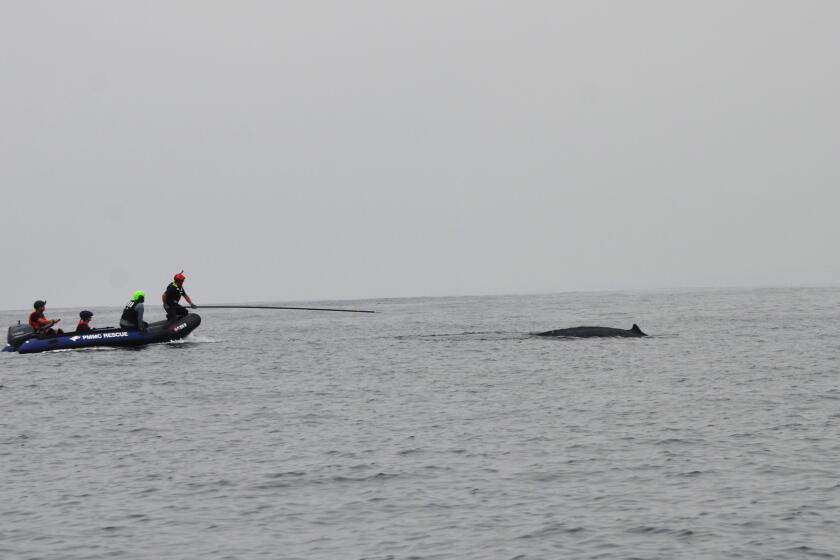O.C. Fossil Digs Yield Bonanza for Scientists
Scientists say they have made some spectacular discoveries among at least 3,000 fossils dug up in northeastern Mission Viejo, including previously unidentified species of whales, crabs and fish.
The fossils, experts say, are 10 million to 15 million years old and confirm theories that the shoreline once extended from inland Camp Pendleton northeast to Chino and that Southern California was once a region of tropical temperatures.
“The new finds have the potential for resolving issues that we’ve been trying to address since the 1960s,” said J. D. Stewart, assistant curator of vertebrate paleontology at the Los Angeles County Museum of Natural History.
The fossils were unearthed by Orange County paleontologists John Minch and Thomas Leslie, two Saddleback College professors whose San Juan Capistrano paleontological firm is monitoring excavation work on the Foothill Transportation Corridor.
Upon completion, the 30-mile tollway will link the Riverside Freeway to Basilone Road in Camp Pendleton, traversing the rolling hills east of Interstate 5.
The discoveries, Minch and Leslie said, indicate that hills now dotted by thousands of tract homes were once ocean beds full of sharks, whales and other marine life.
A county ordinance and state law require that developers hire qualified archeologists and paleontologists to monitor construction work that is likely to show fossils, said Laura Coley Eisenberg, an environmental analyst with the corridor agency.
The discoveries are not expected to impede construction of the tollway, scheduled for completion by the year 2000.
In addition to the fossil finds, experts have uncovered hundreds of tools and other items once used by the Gabrielino Indians.
Michael Macko, who was contracted to perform the archeological monitoring, said that in the past several months, he has found about 400 items dating back 8,000 years--hammer stones, grindstones and shark teeth that were used by once-indigenous Indians.
“The items show that these people had a very elaborate knowledge of the environment,” Macko said. “But they did not live or bury their dead here. It was a limited processing site, but it was not very archeologically rich.”
But for Minch and Leslie, the dig site on the west side of Upper Oso Reservoir, near El Toro Road and Los Alisos Boulevard, turned out to be a paleontological gold mine. Among the finds were never-before-found teeth of a now-extinct whale.
Since excavation work began in November, the paleontologists have used equipment ranging from 30-ton tractors to tiny dental picks to uncover remains of whales, sharks, sea cows and porpoises.
As a fleet of tractors roared nearby last week, Minch and Leslie stood in the hot sun amid a pile of rubble on a dusty, sunbaked hillside. The peaks of the Santa Ana Mountains rose in the hazy distance.
Minch and Leslie used picks and chisels to split the shale. Occasionally, Minch would squint into his microscope. Then he smiled and excitedly invited visitors to see his latest find--an 11-million-year-old crab fossil perfectly embedded in shale.
The paleontologists read rocks the way book lovers read novels. They looked at some perfectly preserved avocado leaves and other plant fossils that they said prove that Southern California once experienced the kinds of tropical temperatures characteristic of present-day La Paz, Mexico.
The kelp and marine fossils prove that the area from Camp Pendleton to Chino--through Coto de Caza, Mission Viejo, Irvine and Tustin--was once under water. But during the past 15 million years, vertical movement of the earth caused a general elevation of the West Coast.
“The same kind of movement is continuing today,” Minch said. “So in another 10 to 15 million years, at 2 inches a year, Los Angeles and Orange counties (will) be in San Francisco.”
Some scientists said they are excited although not surprised by the latest Mission Viejo discoveries.
Lawrence G. Barnes, curator of vertebrate paleontology at the Los Angeles museum, said that 10 years ago, he collected 30,000 fossils ranging from small fish and shark teeth to parts of camels in the same area.
“We predicted these continuing fantastic results,” said Barnes, who is considered one of the world’s leading scientists in his field. “The latest discoveries confirm that this area near Oso is one of the top 10 marine fossil-producing areas in North America.”
Stewart of the Natural History Museum was thrilled to hear that the paleontologists had found complete fossils of pseudoseriola , a mysterious ancestor of what some scientists believe to be the bluefish--a commercial food fish native to the Atlantic coast of North America.
Stewart said he has found “bits and pieces” of the fish in Central and Southern California but that the latest Orange County discovery is probably the best specimen so far.
“If it could be determined that this fish existed” in both the Atlantic and Pacific oceans, “then something like weather conditions changed to make them extinct here,” he said.
Stewart said the crab fossils uncovered would be of particular interest to scientists who study crustaceans.
“It’s pretty rare to find crabs in Miocene rocks,” Stewart said. “I’ve never seen them in Southern California.”
Barnes said the scientific value of the discoveries will be determined by researchers who usually spend hours analyzing and documenting the fossils.
“These fossils would probably add to our knowledge,” Stewart said, “by telling us how organisms changed with time and how organisms responded to climatic changes. It would explain the big picture better.”
Minch and Leslie said some of their fossils are bound to generate new interest among other scientists. “Some of the fossils, like the crabs,” Leslie said, “are so new to us because there are no descriptions of them in the scientific literature. We are having to start from scratch.”
The paleontologists had planned to display some of the fossils at a natural history museum in Aliso Viejo, but that county facility closed a few months ago, soon after it opened.
The fossils have been placed in about 100 cardboard boxes and stored in a county warehouse in Santa Ana.
Barnes--who wrote the Orange County ordinance that requires the monitoring of sensitive fossil sites, and who served on a county committee that recommended the building of a museum to house the artifacts--lamented that the public is not getting a chance to see the fossils.
“There is little doubt that Orange County can support this kind of museum,” he said. “The county made a law to pick up the fossils, but after 13 years they still have no place to put them in.”
Digging Up Ancient Mysteries
Fossils unearthed along the Foothill tollway route proved that about 15 million years ago, the sea extended east into what is now the Cleveland National Forest. The fossil discoveries include several previously unidentified types of sea animals.
Submerged Beneath the Waves
In prehistoric times, marine mammals swam in warm, shallow sea, and subtropical plants thrived onshore. Today’s shoreline shape began to emerge about 4 million years ago as geological changes lifted the area.
The Fossil Hunt
Since November, scientists have been digging fossils along portions of the proposed Foothill tollway route.
Crab Fossils Discovered
Fossils of a previously unknown species of crab were discovered. They are the first crab fossils found in the Southern California area.
New Whale Surfaces
A new species of toothed whale, estimated to be the size of today’s killer whales, turned up in sediment where shallow water once stood.
Forests of Avocado
It has long been known that avocado trees were common the county. Scientists have found several near-perfect leaf fossils at the dig.
Sources: Paleontologist John Minch; World Book Encyclopedia
More to Read
Sign up for Essential California
The most important California stories and recommendations in your inbox every morning.
You may occasionally receive promotional content from the Los Angeles Times.






